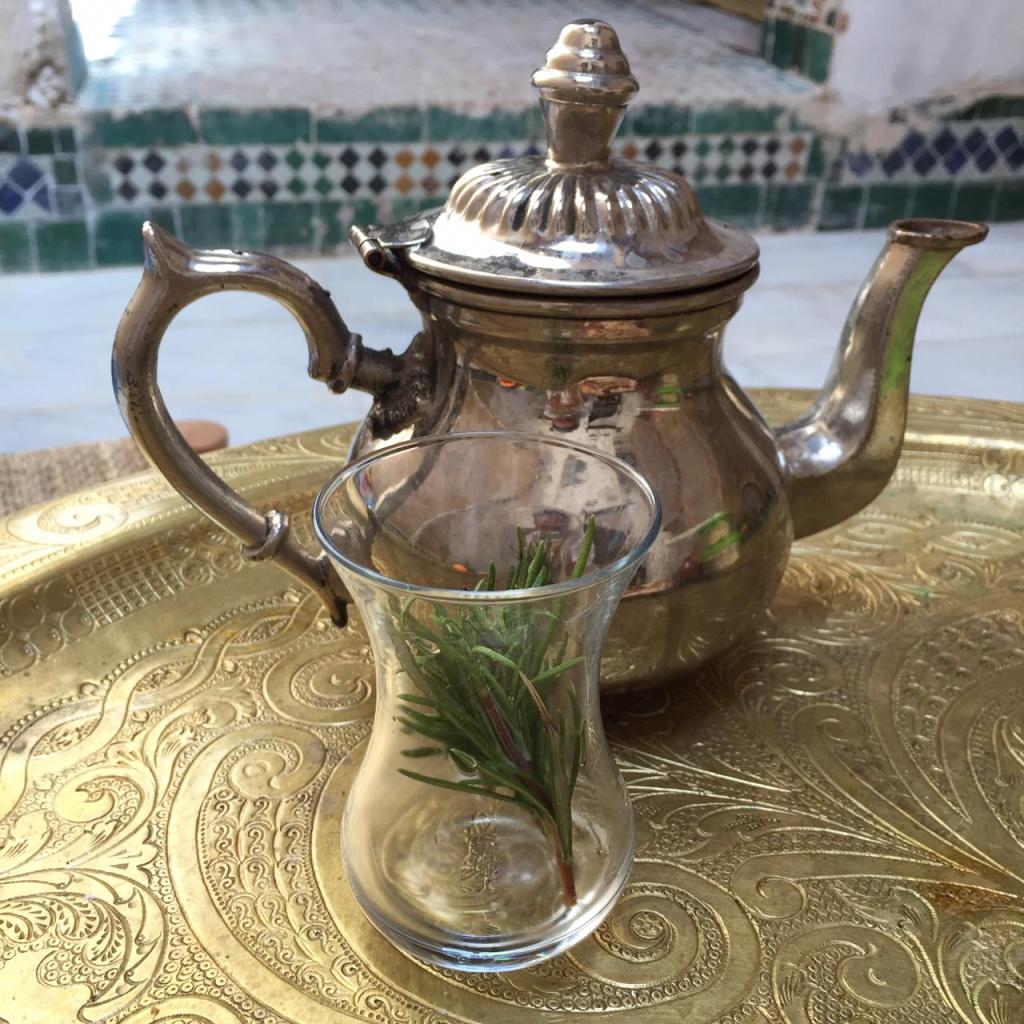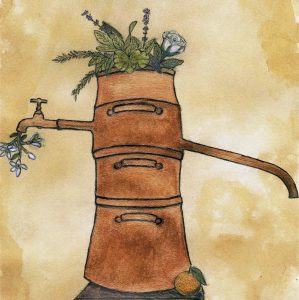Morocco is famous for its tea.
Walk through any Moroccan market and you’ll find fresh fragrant mint being sold in huge bunches, piled high and sold for a dirham.
As you move around the medina of Fes, you’ll find carts laden with fresh herbs. Marjoram, Thyme, Rosemary, Verbena, Pennyroyal, Wormwood and Sage.
Enter any Moroccan kitchen and you might find a bunch of herbs drying in a high corner, but most definitely, you’ll find a teapot.
I am an unapologetic tea lover (something Brits have in common with their Moroccan counterparts). I binge drink tea, and with long days at home there always seems to be a good opportunity to brew up another pot.

I must admit though, that for years I didn’t make Moroccan tea. Old habits die hard, and there was nothing like a big mug of milky black tea to get me going in the morning.
Now, as a full convert to Moroccan tea, this sounds so strange. But, it was hard for me to give up on my old English brew. Two factors stopped me from taking the plunge and making the change to Moroccan green tea, drunk from a dainty little glass.
The first factor, was sugar. This is the dark side of Moroccan tea. You might enjoy drinking the final product, but if you see how much sugar is loaded into your pot in most restaurants here, you’d cower.
I’m a sensitive soul and my body can’t take much sugar, so for years I didn’t make Moroccan tea because I felt it ‘needed’ that level of sweetness.
The second factor that stopped me from making Moroccan tea was the ritual that surrounds the Moroccan tea ceremony. It can seem intimidating when you see a Moroccan make and serve tea, especially in the home, because the act is steeped in deep tradition.
The height from which the tea is poured, ostensibly to oxidise the tea but a performance in itself, is one aspect. How many times am I supposed to pour the tea out before it’s finally readily to serve? Will people like it? What if I get it all wrong?
It’s been a while since I cared quite this much about what people thought, but it’s still taken me too long to start making good, healing, soulful Moroccan tea.
It was eventually my mother-in-law who pushed me over the edge.
She always made the most beautiful, herbal Moroccan tea which she claimed had no sugar in. I couldn’t quite believe it, because at times when I’d ask for a sugarless cup in a cafe, I was served a liquid that barely resembled a refreshment, it was so incredibly bitter.
Instead, her tea was subtle, just a little bitter but balanced with the natural sweetness of the herbs. It wasn’t dark, but a rich buttery orange. When I drunk it, I felt completely revived.
My husband finally bought us a proper Moroccan teapot (he comes from a family of teapot makers, so how we didn’t have one for years of our marriage, I don’t know), and I got to work.
My mind finally opened to the truth. Moroccan tea CAN be healthy! It can be subtle and comforting. And it can be easy! It is, most definitely, healing.
This, I believe is the essence of Moroccan tea. A true elixer for the soul and the body.
I know this is dangerous territory to stand on. Most of my Moroccan friends love their sugar with a bit of tea! What I’m suggesting here, is a completely different drink. And I do believe, and I have it on good authority (thanks, Latifa!), that this is the PROPER stuff.
How to Make a Healing Pot of Moroccan Tea
Firstly, what’s so healing about it?
The base of this tea is dried green tea leaves. I do NOT mean green tea from a tea bag! If you try to make this with the soft leaves found in a tea bag it will not work! You will end up with something completely undrinkable.

Whole green tea leaves, gently processed, are packed with health benefits. Antioxidant, antibacterial, cleansing and and packed with minerals. They help restore or body’s cells, preventing various diseases, including cancer.
The other major component to this tea is Moroccan mint. Mint is packed with cleansing goodness, aids digestion, reduces stress and improves focus. It is full of vitamins and minerals.
Having said that, you don’t HAVE to use mint in this recipe. Yes! Moroccan tea can be made with pretty much ANY fragrant, healing herb. Many people use mint as a base and add other herbs on top, but you can use any combination of healing herbs, according to your health needs. Just remember that some herbs (particularly sage, pennyroyal, wormwood and verbena) do have contraindications so if you have any health issues, do your research on this first.
I’m going to offer a variation that has mint as the base of this tea, but you can swap this in and out as you prefer.
You Will Need

- A good stove-top teapot
- Whole dry green tea leaves
- 3-4 long stems of Moroccan mint (or peppermint if you don’t have Moroccan mint available)
- A handful of any other herb(s) of your preference. I would recommend a combination or one of the following: Rosemary, Marjoram, Verbena, Thyme, Pennyroyal, Wormwood, Sage, Lavender.
- Small glass cups
- Optional: orange blossom water or rose water
Unless you have a local market well stocked with fresh herbs, I would recommend keeping these herbs in pots at home so they are fresh and accessible whenever you need them. Moroccan mint is readily accessible in many garden centres across the world.
Method
Boil your water. I prefer to use a stove-top kettle for this, but any method is fine. I just like fire. Do NOT use water that has previously been boiled.

Place 1-2 large spoonfuls of green tea leaves in a teapot. The amount you need will depend on the size of the pot, you will learn over time. I use about 1.5 spoonfuls in my 3-4 person pot.
When your water is freshly boiled, pour a few centimetres of water over your tea leaves, stirring them gently by swirling the pot by the handle. Place the teapot over a low heat on the stove and simmer for 1-2 minutes.
Meanwhile, wash 3-4 large stems of fresh Moroccan mint, ensuring it is thoroughly clean. Crush the leaves and stems in the hand, wring them and fold the stems in half. This will release the fragrance and essential oils into your tea.

Place the mint carefully inside the teapot and pour the rest of the hot water over them, until your teapot is full, but not overflowing.
Allow the teapot to simmer over the heat for another 2-3 minutes, but do not allow it to boil. If it looks as if it will boil, turn the heat off completely and leave the pot resting on the hot stove for a little while.
Turn off the fire and leave to stand over the hot stove for five minutes.
In small glass cups, place fresh washed stems of the healing herbs you need. Rosemary is great for remembrance, thyme is good for a sore throat, and a small amount of lavender is wonderfully relaxing.

After your tea has brewed, take an EMPTY glass cup and pour your tea in, the greater height you do this from will help increase the flavour of the tea by oxidising it, but be careful not to burn yourself in the process!
Carefully, pour the tea you have poured back into the pot and repeat this process 3-4 times until the tea that you pour has a nice foam of bubbles on top. This helps the fragrance of the mint spread evenly through the teapot.
Now, pour your tea into the cups you intend to drink from, onto the fresh herbs, again from a small height.
At this point, adding a small amount of orange blossom or rose water will add lovely fragrance and healing benefits to your tea, but be careful not to add too many flavours together so that the taste of your tea remains well-balanced.

Allow the herbs in your cup to infuse into your tea for a few minutes, and then drink away!
If you find that this method is too bitter, try adding a small spoonful of pure honey to soften it a little.
Is the tea dark in colour and bitter? You may need to reduce the amount of tea leaves in the teapot, or reduce the time spent over the fire. Your tea should be a warm orange colour, not dark brown.
How do You Like Your Tea?
Get in touch and let me know how you get along with this recipe, what herbs you use, and how it turns out!
The brewing of tea is a true art, one that we cultivate over time. So don’t worry if it isn’t perfect on your first try.
Are you a sugar lover? I’d love to see what you think of this, if you’re used to normal, sugar-packed Moroccan tea!
This, for me, is all I need to refresh myself and give myself a moment of calm on a difficult day. Just thinking about it makes me swoon!


Reading your articles is soothing! Thank you!
Moroccan tea (with no sugar) gives me power away from home (morocco) and I ll be willing to add more fragrances to it aftear reading your article.
I started using “bio” green tea leaves and I wonder if you agree that the other types may be loaded with pesticides or shall I just come back to the brand you showed?
LikeLike
Hi Sara! Of course, organic is always better. I just use what is available to me if I can’t find an organic brand.
LikeLike
I’ve so enjoyed my little visit to your corner of the internet, filled with some of my favourite things, and to finish tea. Reading this I feel I just joined you for a glass. Masha Allah you’ve inspired me to give Moroccan tea another try.
LikeLike